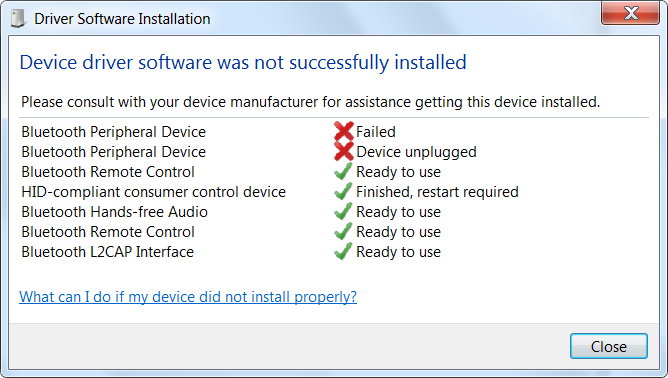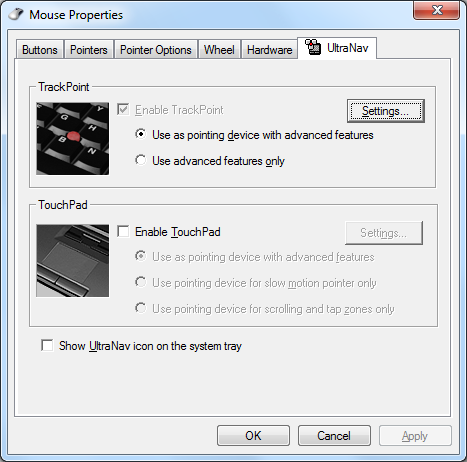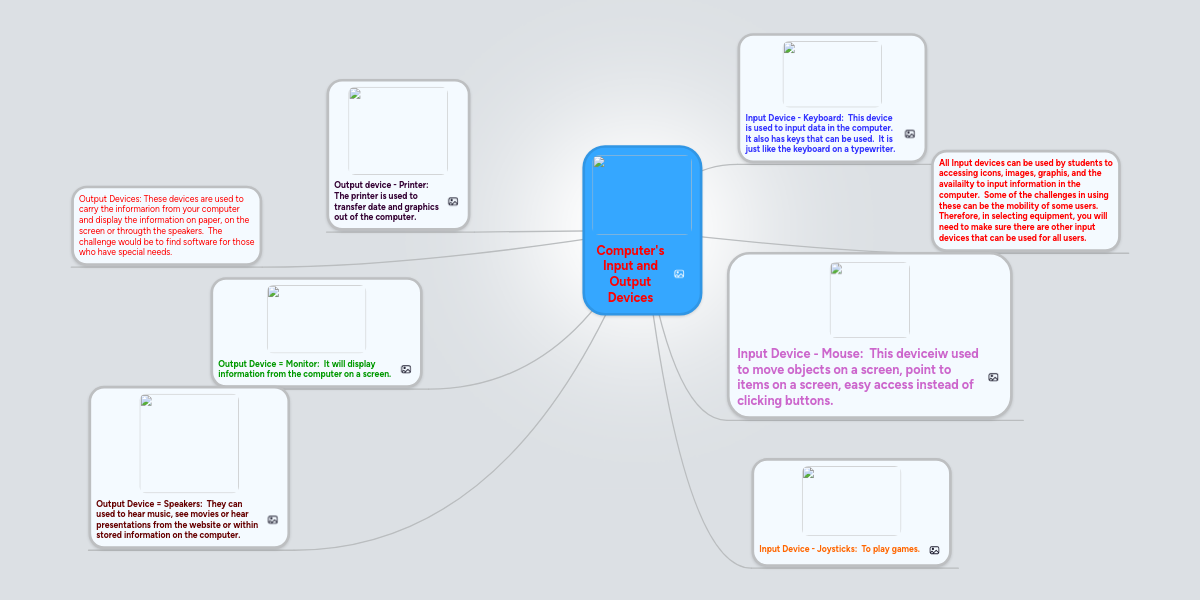An input driver is a device driver used for instructions for how the computer should communicate with an input device. Related pages A listing of computer drivers is available on our driver software page. The package provides the installation files for Microsoft USB Input Device Driver version 10.0.4. If the driver is already installed on your system, updating (overwrite-installing) may fix various issues, add new functions, or just upgrade to the available version. With my device driver I want to set just the GPIO pin 10 as output and read GPIO pin 14 as input. So I have to write a set up command into the “function set 1” register with offset 4. To get a clear situation I first set all GPIO pins 10 to 19 as inputs by the command. The drivers stay, yes. But the devices do not (at least not visable in the device manager). The registry keeps track of devices and their device id# anytime something is connected/installed. Under WinOS normal mode, old devices shouldn't be showing in the device manager, that is not normal at all. Hard Drive Installation (via WinZip) with Setup.exe File Download 1.Click Download File to download the file. When the File Download window appears, click Save or Save this program to disk and click OK.
Cleanup: This page should be cleared off in preparation for deletion. Tuner specific information should be migrated to the LinuxTV Wiki, and any additional information moved to more generic pages. Discuss the issue on the talk page
- 1Ubuntu 9.10 Installation on Foxcon 45CSX - Intel ATOM 330 CPU
- 1.2Kernel / Packages
- 1.7Getting Your Australian Channel Listings
- 1.8MythVideo
- 1.9Remote Control (Lircd)
This documentation is my working notes for installing the DViCO FusionHDTV DVB-T Dual Digital 4 onto an Ubuntu 9.10 (Karmic Koala) Distribution.


Hardware
I bought the following Setup on 20/11/2009 from http://www.gamedude.com.au. I dislike them because you have to wait so long in line to purchase and after sales service sucks but they do have a good selection of cases:An alternate source is http://www.umart.com.au but not as many cases.
- TV Card - DVico FusionHDTV DualDigital 4 Low profile - $149
- Micro ATX Motherboard - Foxconn 45csx Intel Atom 330 DualCore CPU Video Sound - $119
- Case - 65x265x300mm - AYWUN MD-100 Black Mirror Front Mini ITX Case External Power - $89
- Memory - TeamElite 2gig DDR2 800Mhz PC2 6400 CL5 - $59
- HardDrive - Samsung 1TB Sata-2 32meg Cache - $105
- DVD Burner - SONY SLIM Internal DVD-RW Drive BLACK 8x DVD+/-RW SATA - $79
- MOLEX TO SATA POWER + DATA CABLE 15CM - $12
- NetComm 802.11N Draft 2.0 Wirless USB Adaptor MODEL : NP910N - $59
- TOTAL - $671
The case only has 1 sata power connector and comes with very short sata cables not long enough to reach the hard drive. Which is why I bough the Molex->Sata Power+Sata Data adapter.
Kernel / Packages
Warning: After installing Ubuntu Karmic and logging into the gnome desktop the system suddenly froze. I suspect this is because of the intel graphics driver. After a bit of googling I found this solution:
After you log in hit: Ctrl-Alt-F1 to take you to a terminal before it freezes. Then log in to the terminal and type:
Hit Ctrl-Alt-F7 to take you back to the altered gnome desktop. Open up a terminal and type
The problem is intel driver not behaving nicely with compiz.
Check your DVB TV Card
After you have a stable setup check the messages to make sure your card was detected:
You should also see the directory's /dev/dvb/adapter0 /dev/dvb/adapter1
Check your CPU
The Atom 330 is a dual core processor with hyper-threading so you should see 4 processors:
The Intel Atom reports that it has multiple cores (and HyperThreading) via an ACPI message and will not fall back to another delivery mechanism (like most other platforms) if ACPI is not available.

Warning: If you don't see 4 processors like I did then you will need to add th line acpi=ht to your kernel parameters temporarily. For some reason I added this to my kernel and the processors showed up but the mythtv menu was unbelievably slow. I removed it and the menu returned to normal and to my astonishment the 4 processors were still detected. It sounds a bit voodoo to me but it worked. If you need to do this you can use the following commands to add then remove the kernel parameters.
If everything went well the your 4 processors should be detected using cat /proc/cpuinfo. Now try removing acpi=ht from grup using the above steps and see if the 4 processors are still available.
NetComm Wireless N NIC USB

Had a problem with the NetComm 802.11N NP910N not working but after a few searches found the solution. Add the following to the bottom of the usb blacklist file.
Installing MythTV
- Go to: System > Administration > Synaptic - Mark all upgrades and Apply. This will take a while on your new system.
- Search 'mythtv', then mark mythtv & mythplugins for installation. Yes to all and Apply.
- Give your mysql database a root password when asked.
Set up Myth TV
This is my quick and dirty setup. Leave the defaults for everything else (ie Next.. Next.. etc Finish).
- Run mythtv-setup - It should add you to the mythtv group and then log you out
- Run mythtv-setup again - (My screen stayed blank - so hit the up arrow after it starts to prompt it to refresh)
- Go into General > On the second page:
- Go into Capture Card > New Capture Card
- New Capture Card (for your second receiver)
- Go into Video Sources > New Video Source
- Go Into Input connections > [DVB:/dev/dvb/adapter0/frontend0](DVBInput)->(None)
You should see all your channels being found. When it is finished -> Next -> Finish.
- Now do the second input > [DVB:/dev/dvb/adapter1/frontend0](DVBInput)->(None)
Mythfrontend
- Open up mythfrontend to create the configuration files.
- Watch TV - Make sure your card is working
- Go to Utilities > Setup > Appearance
- Page 1
- Page 4 - Localization
Getting Your Australian Channel Listings
Most of the guides have recommended Shepherd however whilst providing good information this thing is a slug and will take ages to complete.
My personal preference is to use Oztivo. Oztivo is 100x faster than shepherd but doesn't provide extra indepth guide information. (Like looking up IMDB for movie information).
The following will give you a step by guide to setting up the Oztivo Guide.
Mapping the Channels
Firstly we need to set up our mapping from our guide data to our channels we found in our last step. Myth found 22 channels but a lot of those channels are repeated this is why we give the same xmltvid to the channels that are repeated. We can also remove visibility of those repeated channels if we desire.
- Open up firefox and go to http://localhost/mythweb.
- Mythtv settings (Key and Spanner Icon top of the screen) -> TV -> Chanel Info
- Enter in your xmltvid and new names:
Getting the Oztivo Guide Data
Background: The old method was to get your channels that you listed in xml format. However oztivo was having too much bandwidth/computational issues and decided to make their xml data static instead of dynamically generated. Unfortunately this makes getting the data a little more complicated than before. Luckily for us Auric had made a script to get the data.
- Head over to http://www.oztivo.net/twiki/bin/view/Guidedata/WebHome and Sign Up.
- Download the program, get the support modules and configure it:
Now go through the configuration skipping the first question and changing your path to the downloaded oztivo files:
When you get to the xmltvid section place in the xmltvid from your mappings for the channel you want to download. eg 7TWO becomes 7-2:
Finally it should spit out the following:
Time to test out the script
That should probably take about 3 minutes. Check out your program guides:
- Go to Applications > Sound & Video > MythFrontend
- Manage Recordings > Schedule Recordings > Program Guide
If everything looks good we will add this to our crontab:
Add this line to the crontab. This will start the job at 3:36am.
MythVideo
The default lookup inside the mythtv frontend couldnt find some of my video art. So Instead i used Jamu which is already included for us in the myth folder.
- First copy your video files to the mythtv videos folder and then run the jamu script in interactive mode
- Now open your frontend and go to Utilities Setup > Setup > Media Settings > Videos Settings > General Settings > Page 2/8 > Uncheck 'Show Unkown File Types'. This will prevent the gallery from showing your subtitle files (*.srt)
- Escape back to the Top Menu and go to Media Library > Watch Videos.
- Press <M> to bring up the internal menu and scan for changes.
- Press <I> to bring up the info panel where you can reset you metadata if something went wrong.
To get the latest version of Jamu.py cab be found here
Slow Windows Shares
I was having trouble browsing my Windows 7 shares. Turns out wins is not enabled by default.
Add wins to this line before dns:
Credit to this Dmizer's Guide
Remote Control (Lircd)
You can create a Symlink to correct input device using the following UDEV rule:create update: /etc/udev/rules.d/10-local.rules
The above creates a Symlink device call irremote which you can code in the LIRC config.
OR
Dvico Input Devices Driver
This I found to be the most painful as I was using the wrong driver for a long time. But after i switched it became a breeze. Now on my system i have 2 /dev/input/events that work when you press a button. When i do a cat /dev/input/event3 and press the 0 key on the remote this happens:
So it seems that this should be the one to use.... Unfortunately Not! Something else is parsing the input from your remote and is producing that like a keyboard entry. What you really want is something that produces binary gibberish when you press a button:
If your screen is mangled from catting out that then you can type 'reset' to reset your terminal. So now that we have determined what device we should use it is time to see if we can record our key presses. We will be using the driver dev/input and not the driver dvico like I did for way to many days.Another thing that may stop the following from working is if lircd is running. You can stop it by '/etc/init.d/lirc stop'.
Recording your remote control
Dvico Input Devices Driver Touchpad
This is here for reference or if you have a slightly different remote than mine. You can skip to mapping your remote if you just wish to use my generated files. Otherwise, to record the buttons on your remote do this:
You must get dots when holding down a key and nothing else. If you don't get dots or other symbols are showing up then you either have a driver problem or are using the wrong input. Otherwise out.txt will hold all your keys.
If you have come this far then your remote is working like a charm. Time to map the keys and make lircd run automatically. This is done with 3 files:
Mapping your Remote
Make sure you modify your DRIVER and DEVICE to be the same as you used for irrecord. I also changed START_LIRCMD=false for some reason.
/etc/lirc/lircd.conf
Ok since we have set up these two files lets check our work.
lircd is running with the correct driver and device. Ok let run irw and press some keys (Up, Ok and Start) on our remote
Great Now we have to map these keys so that mythtv can use them. which brings us to our final file lircrc. You should save this file in your user directory as it is for personal mappings of the remote.
MythWeather
Pretty easy to set up and works of the Bom Website. For easier setup I would go to the bom website to look up your particular weather settings as the location for the Weather and Radar may be different. Make sure when you are setting up inside the Mythfrontend to use SI units.
Again credit to Auric's Mythweather Scripts
MythMovies
To get your movie time download the tarball from Jonty's Site.
Dvico Input Devices Drivers
Now in the mythfrontend Movie Times enter your post code and change the grabber to:
A hybrid ATSCUSB 2.0 device from DViCO.
Support for the digital functionality of this USB box was added to the 2.6.16 kernel.1
- 1Overview/Features
- 2Making it work
Overview/Features
It belongs to the class of USB devices codenamed Bluebird.
- S-Video, Composite and audio inputs 1
- dipole antenna
- remote control
Dvico Input Devices Driver Updater
Components Used
It features the following components:
- LG Innotek TDVS-H064F (NIM)
- Infineon TUA6034 (tuner)
- Philips TDA9887 (analog IF demodulator)
- LG DT3303 (digital demodulator)
- Conexant CX25843 (A/V decoder)
- Cirrus Logic/Crystal 533KZ (audio ADC) 2
- Cypress CY7C68013A (FX2LP) (USB 2.0 bridge)
- Note 1: While the hardware supports analog functionality, the driver currently lacks support for these features (support is forthcoming).
- Note 2: Why a 3rd party audio ADC was included in the design is a curious question, given that the Conexant CX25843 is indeed capable of handling audio input sources.
Identification
The output of lsusb -v will reveal that the device has a subsystem ID of: 0fe9:d501
Making it work
Firmware
It requires the firmware file: dvb-usb-bluebird-01.fw
Drivers
The following drivers are needed for this device: